Are you wondering how much traffic WordPress can handle?
When equipped with the right set of tools, WordPress can handle virtually unlimited traffic. We have seen it handle billions of impressions every month.
In this article, we’ll talk about how much traffic can a WordPress website handle, and how to prepare for heavy traffic on your WordPress site.
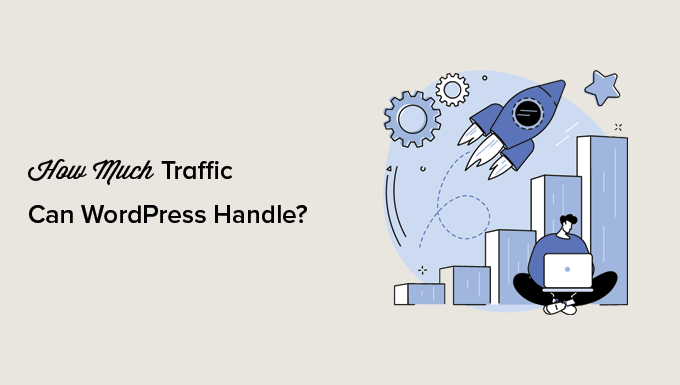
Here is a quick list of topics we’ll cover in this article.
- How WordPress Manages Website Traffic?
- How Much Actual Traffic Can WordPress Handle?
- How Much Traffic Can WordPress Manage on Shared Hosting?
- How Much Traffic Can Managed WordPress Hosting Handle?
- How Much Traffic Can WordPress Handle on Cloud Hosting?
- Handling Billions of Monthly Requests in WordPress
- Tips on Managing Heavy Traffic on a WordPress Website
How WordPress Manages Website Traffic?
A WordPress website stores content in a database. When a user visits a page on your site, WordPress fetches that content and generates the page which then appears on the user’s screen.
As you get more traffic, WordPress has to repeat this process for every user.
As software, WordPress is just code, and it needs some hardware to run on. This hardware is provided by your WordPress hosting company.
It includes a type of computer called a server with software to handle website traffic (Apache and Nginx tend to be the most popular server software). This machine is connected to the internet 24/7 to make sure that your website is always online.
A faster web hosting server allows WordPress to process more requests faster.
A slower web hosting server limits WordPress’ ability to generate those pages quickly.
For more information, take a look at our tutorial on how WordPress really works (behind-the-scenes infographic).
How Much Actual Traffic Can WordPress Handle?
WordPress can handle virtually unlimited website traffic, depending on your hosting platform and caching setup.
The only limit on how much traffic your WordPress website can handle is your hosting platform.
And that’s not just WordPress. All websites, regardless of what website builder they are using, need to rely on the hosting provider to handle more traffic.
Depending on how much traffic you are getting, you can then add more resources to your hosting plan to manage more traffic.
That being said, let’s take a look at some real numbers.
We’ll break it down into different types of hosting plans and how much traffic your WordPress website can manage on those platforms.
How Much Traffic Can WordPress Manage on Shared Hosting?
Shared hosting is the most common type of hosting plan used by the majority of WordPress websites.
It is suitable for small business websites, new blogs, and low-traffic websites.
Shared hosting plans are budget-friendly because they split sever resources among several customers.
To make sure that all customers get good service, shared hosting companies place different limits on how much traffic a customer can get on their websites.
These limits vary from one hosting provider to another, and they are not made public to prevent abuse.
Some shared hosting providers have incredibly fast servers, and access to larger data centers with high bandwidth. This allows them to provide generous resources to their shared hosting customers.
Other providers may cut costs by choosing low-cost data centers with restrictive bandwidth caps. They may not be able to offer much flexibility and will start blocking requests more frequently during peak hours.
Our top pick for shared hosting providers include Bluehost, SiteGround, and Hostinger.
All three of these companies provide generous resources for small businesses, and they each have hosting plans to grow with you as your business grows while keeping the costs affordable.
They have ultra-fast servers operated by state-of-the-art data centers, higher bandwidth, and superior technical expertise to provide a much better user experience to their customers.
They deploy in-house solutions to handle traffic, with built-in caching and behind the scene server tweaks.
We ran our own tests on Bluehost servers to see how much peak traffic they can handle. Here are the results:
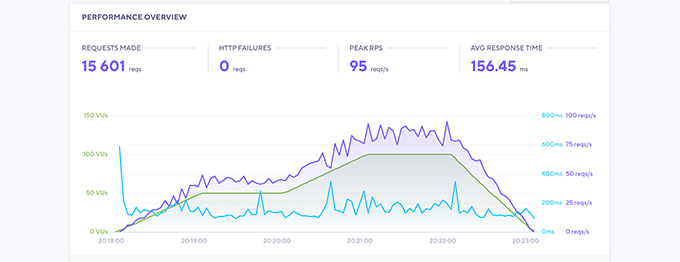
We gradually increased traffic to 100 users at a time within a 5-minute period. As you can see that it didn’t crash and remained quite stable throughout the test.
The folks at Bluehost are offering WPBeginner users a generous discount on hosting with a free domain name. You can start with just $2.75 / month.
How Much Traffic Can Shared WordPress Hosting Handle?
A good shared hosting company can comfortably handle traffic between 10,000 pageviews to 100,000 pageviews per month.
However, you’ll need to optimize WordPress performance to get better results. Some hosts automatically add WordPress acceleration and optimization to help you handle more traffic.
For example, Hostinger on their shared Pro plan can handle up to 200,000 visitors monthly.
Whereas, SiteGround on their GoGeek plan can handle upwards of 400,000 visitors monthly.
Your experience may still differ from the estimates above based on how complex your website is and what resources it requires, but the above estimates are true for vast majority of small business websites.
Don’t worry, we’ll talk later about saving those server resources to efficiently use your hosting plan.
How Much Traffic Can Managed WordPress Hosting Handle?
Once you have utilized your shared hosting plan to the maximum, you will need to upgrade your hosting plan.
Managed WordPress hosting is like the concierge service for WordPress websites. Your hosting provider will take care of updates, security, backups, and more.
Since they are focused on WordPress websites, they deploy additional tweaks to their server technologies to make WordPress run faster and perform reliably under stress.
On top of that, managed WordPress hosting plans make it super easy to scale up your server resources when you get sudden huge traffic spikes.
WP Engine is our top recommendation for a managed WordPress hosting platform.
They are pioneers in the managed WordPress hosting industry and leading the way with state-of-the-art infrastructure and top-notch customer support.
We ran our own tests on WP Engine by sending up to 100 virtual visitors within a short period of time. Here are the results:
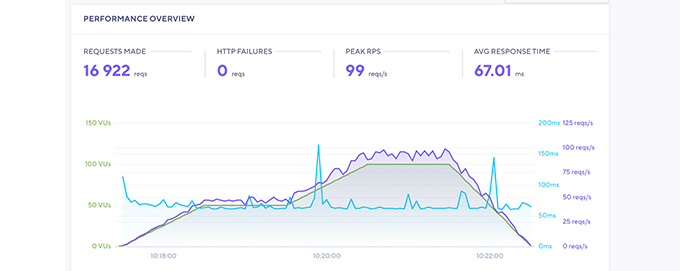
As you can see, our test site remained stable throughout the period with a very low response time.
If you want to look for an alternative, then we recommend SiteGround. They are also a WordPress-recommended hosting provider.
How Much Actual Traffic Can a Managed WordPress Hosting Plan Handle?
A managed WordPress hosting plan can easily handle traffic of 400,000 visitors into millions of page views per month.
For example, SiteGround on their GoGeek plan can handle upwards of 400,000 visitors monthly.
WP Engine on their Managed Scale plan can also handle upwards of 400,000 visitors monthly.
And both of them offer custom plans for sites that are larger than this.
For example, our WPBeginner website along with other sites are hosted on SiteGround’s custom managed platform, and we receive hundreds of millions of requests each month.
We also know several super large websites that receive tens of millions of visitors that use WP Engine.
When you’re on a managed WordPress hosting platform, they can handle any amount of traffic needed. You just have to pay the additional hardware costs.
How Much Traffic Can WordPress Handle on Cloud Hosting?
For shared and managed WordPress hosting, you share server resources with other customers.
On a cloud hosting platform, you get guaranteed resources on a cloud platform made up of several servers. If one server fails, your website will remain available on other servers.
Due to this redundancy, guaranteed resources, and enterprise-grade availability, cloud hosting is suitable for large businesses, busier eCommerce stores, and other enterprise clients.
We recommend using SiteGround Cloud Hosting. They use the Google Cloud Platform and offer free CDN, unique IP address, enhanced security, and priority support 24/7.
WP Engine, Kinsta, Rocket.net, and others can also create custom cloud platforms based on your hosting needs.
How Much Actual Traffic Can WordPress Handle on Cloud Hosting?
A proper cloud hosting platform can allow WordPress to handle millions of pageviews per month without any hiccups.
For example, Rocket.net public pricing shows that they can handle upwards of 5,000,000 visitors on their Enterprise plan because they use 20+ server locations along with a smart Cloudflare cache.
You can see our performance test results in our detailed Rocket.net hosting review.
Handling Billions of Monthly Requests in WordPress
Now when most people think about WordPress, they think of it as a blogging platform, but the reality is that WordPress is the most popular website building platform on the planet with over 43% market share.
There are even full-blown SaaS apps that are built using WordPress.
For example, we built a popular conversion optimization software OptinMonster which underneath is powered by WordPress.
We process billions of requests each month, and that’s all WordPress.
So when someone says WordPress doesn’t scale, they are clearly misinformed, or simply lack the expertise themselves to do it.
You should challenge their perspective and find another WordPress consultant that has the expertise to scale WordPress.
What do you need to handle really large traffic in WordPress?
This is where you need Enterprise Custom Cloud Hosting on platforms like Amazon Web Services or Google Cloud.
These companies provide cloud servers that you can sign up for and create your own custom hosting environment.
You can add as many CPU resources, memory, storage, or geographical locations as you need.
You will be billed on a pay-as-you-go basis for the resources you have utilized. That’s why you’ll need your own team of server admins to efficiently use these resources.
Luckily, you don’t have to become a DevOps team either. Companies like WP Engine, SiteGround, and others can build and manage these custom clouds for you.
How Much Traffic Can Enterprise Cloud Hosting on AWS or Google Cloud Handle?
Enterprise custom-built cloud hosting on AWS or Google Cloud can handle extremely large volumes of traffic.
They can be configured to handle millions of hits per day or even billions of pageviews per month.
Our app OptinMonster runs on AWS and powers billions of requests without any hiccups.
You can combine it with a CDN and web-application firewall like Cloudflare for further scalability.
For example, our WPForms website is hosted on Google Cloud managed by SiteGround. We use Easy Digital Downloads to handle our eCommerce and software licensing which means for a plugin with over 5 million active installs, we’re receiving billions of requests each month across our portfolio.
Aside from Google Cloud, we’re using Cloudflare to efficiently scale our WordPress eCommerce site.
Tips on Managing Heavy Traffic on a WordPress Website
WordPress does a very good job of reducing the server load and processing requests so your users can get to your website as quickly as possible.
However, there are so many things that you can do to further optimize that performance. Below, we outline some of the most important practices that you can implement on your website for the best performance.
1. Always Get The Best WordPress Hosting for Your Budget
The web hosting industry is highly competitive, and there are tons of companies offering unlimited bandwidth, unlimited this, and unlimited that.
Don’t fall for false advertisements. Do your own research and sign up for the most trusted hosting providers in the industry. Unlimited rarely actually means unlimited.
For instance, if you were looking for a shared hosting provider, you can compare these top WordPress hosting companies as a starting point.
Choosing an unreliable WordPress hosting company will make your website slower, and it will not be able to handle much traffic.
2. Turn on a Caching Plugin
What if instead of generating pages repeatedly, you save them temporarily on your WordPress server and reuse them?
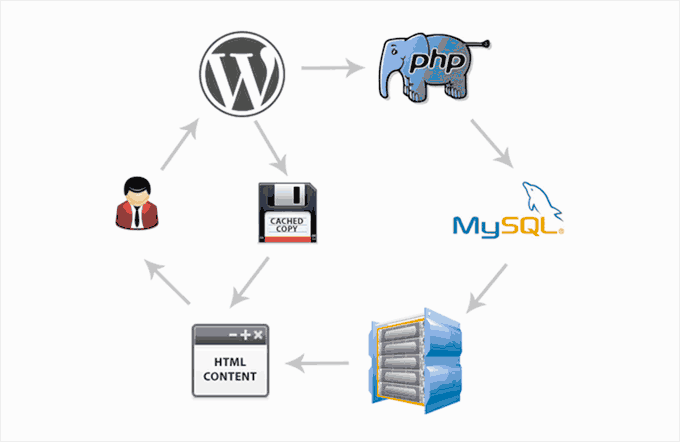
This technique is called caching. When you update something on your website, the cached version is deleted, and the newly updated content is served to your users.
Most WordPress hosting companies like Bluehost, Hostinger, and SiteGround come with their own built-in caching solutions that are turned on by default. However, if you are unsure, just ask their support staff to turn it on for your website.
Alternatively, you can use WP Rocket, which is the best WordPress caching plugin on the market.
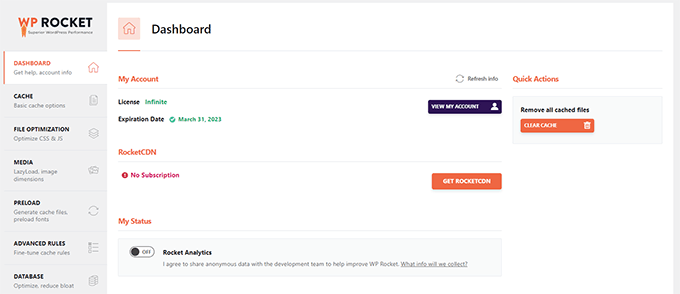
It is beginner friendly, and once you turn it on, you don’t need to worry about the technical stuff as it automatically configures the best settings for most websites.
3. Use CDN for Static Content in WordPress
Using a CDN or content delivery network allows you to serve static files like images, javascript, and CSS, using separate servers.
This reduces the load on your WordPress server and frees up resources to process more traffic requests at faster speeds.
We recommend using Bunny.net they are one of the best CDN services on the market. Adding it to your WordPress website is super-easy even for absolute beginners.

Alternatively, you can use the Cloudflare Free CDN, which some hosting providers such as SiteGround include as a base option within their platform.
4. Filter Bad Traffic with Firewall
Bad traffic is the traffic generated by malicious spam bots, hackers, and DDoS attacks. These are not genuine website visitors, and they could waste a lot of your server resources and make WordPress slower.
A DNS-based website firewall service blocks such traffic even before it reaches your website. This saves you a ton of server resources and your WordPress website can cater to your genuine visitors.
We use Sucuri on the WPBeginner websites and Cloudflare on others. See our list of the best WordPress firewall services on the market.
We hope this article helped you learn how much traffic WordPress can handle. You may also want to follow our WordPress performance optimization handbook or take a look at these tips on making high converting sales funnel.
If you liked this article, then please subscribe to our YouTube Channel for WordPress video tutorials. You can also find us on Twitter and Facebook.
The post How Much Traffic Can WordPress Handle? (+ Expert Scaling Tips) first appeared on WPBeginner.
from WPBeginner https://ift.tt/lbjmIFQ
More links is https://mwktutor.com
No comments:
Post a Comment